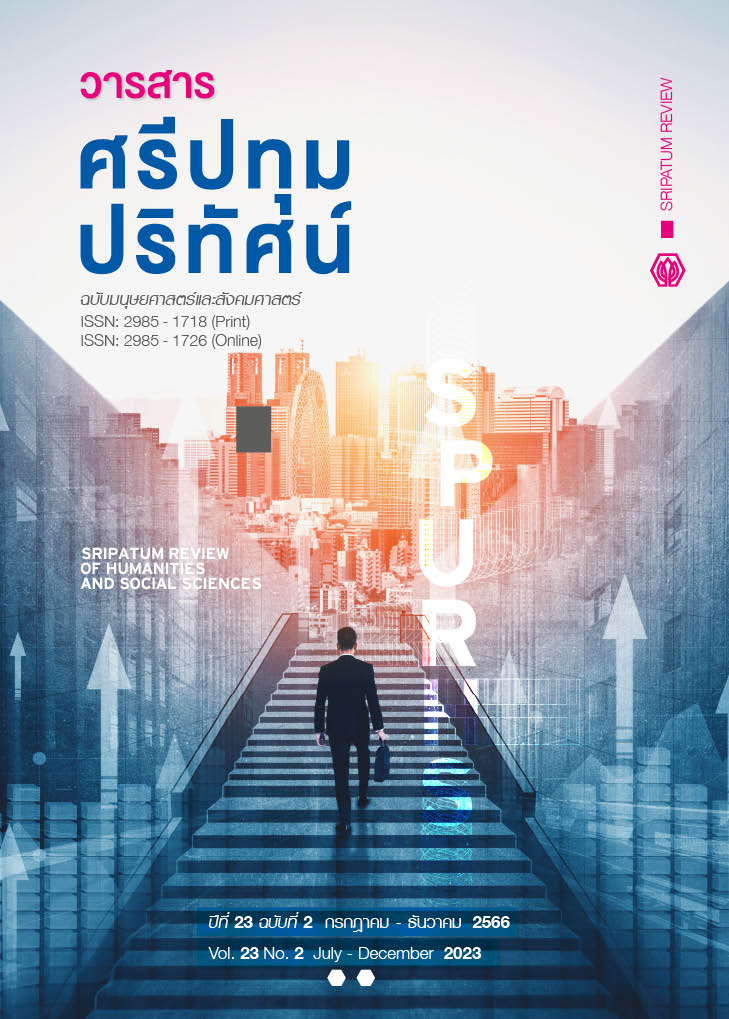Perceived Motivation Differences for Cyberbullying of University Students in Thailand: Impact of Urbanization
Main Article Content
Abstract
Urbanization causes both prospects and challenges; urban settings can lead to significant inequalities and social problems. Cyberbullying is a major social problem and presents a dangerous threat in today's digital world to youth and adults alike. The objectives of this study were to study cyberbullying experience and the perception of cyberbullying motivation of Thai university students. In addition, this study investigated the difference in cyberbullying experience and perception of cyberbullying motivation of Thai university students living in urban areas and rural areas. This study employed cross-sectional design and conducted with university students who were 18-25 years of age with a sample of 392. Results indicated that there was no difference between the proportions of university students in urban and rural areas reporting both cyberbully perpetrators and cyberbully victims. However, students in urban areas tended to perceive anonymity as a motivation for cyberbullying more than students in rural areas. On the other hand, students in rural areas tended to perceive enjoyment as a motivation for cyberbullying more than those in urban areas. The findings help promote understanding of motivational factors, which may assist in prevention and intervention when dealing with cyberbully perpetrators.
Article Details

This work is licensed under a Creative Commons Attribution-NonCommercial-NoDerivatives 4.0 International License.
1. กองบรรณาธิการสงวนสิทธิ์ในการพิจารณาและตัดสินการตีพิมพ์บทความในวารสาร
2. บทความทุกเรื่องจะได้รับการตรวจสอบทางวิชาการโดยผู้ทรงคุณวุฒิ แต่ข้อความและเนื้อหาในบทความที่ตีพิมพ์เป็นความรับผิดชอบของผู้เขียนแต่เพียงผู้เดียว มิใช่ความคิดเห็นและความรับผิดชอบของมหาวิทยาลัยศรีปทุม
3. การคัดลอกอ้างอิงต้องดำเนินการตามการปฏิบัติในหมู่นักวิชาการโดยทั่วไป และสอดคล้องกับกฎหมายที่เกี่ยวข้อง
References
Balakrishnan, V. & Norman, A. (2020). Psychological motives of cyberbullying among Malaysian young adults, Asia Pacific Journal of Social Work and Development. 30(3), 181-19.
Barlett, C.P., Gentile, D. A., & Chew, C. (2016). Predicting Cyberbullying from Anonymity. Psychology of Popular Media Culture. 5(2), 171–180.
Compton, L., Campbell, M., & Mergler, A. (2014). Teacher, parent and student perceptions of the motives of cyberbullies. Springer, 1-35.
Childnet International. (2016). Understanding, Preventing and Responding to Cyberbullying. [Online]. Retrieved December 15, 2021, from: https://www.Chilnet.com.
Dordolo, N. (2014). The Role of Power Imbalance in Cyberbullying. Inkblot: The Undergraduate Journal of Psychology. 3, 35-41.
Euajarusphan, A. (2021). Cyberbullying and Thai Generation Z Youths in Bangkok, Thailand. International Journal of Crime, Law and Social Issues, 8(2), 43-55.
Ghosh S., & Pramanick, S. (2021). Assessing Psychological Effects of Cyberbullying on the Adolescents of a Cosmopolitan City. Space and Culture, India, 8(4), 89-105.
Gradinger, P., Strohmeier, D., & Spiel, C. (2012). Motives for bullying others in cyberspace: A study on bullies and bully-victims in Austria. In Q. Li, D. Cross, & P. K. Smith (Eds.), Cyberbullying in the global playground: Research from international perspectives (pp. 263–284). Wiley Blackwell.
Hamuddin, B., et. al. (2019). Do They Truly Intend to Harm Their Friends? The Motives Beyond Cyberbullying among University Students. International Journal of Cyber Behavior, Psychology and Learning. 9(4), 32-44.
International Telecommunication Union, ITU. (2021). E-learning in Thailand: Mapping the digital divide. Geneva: ITUPublication.
Kilenthong, W., & Odton, P. (2014). Access to ICT in Rural and Urban Thailand. Telecommunications Policy. 38(11), 1146-1159.
Kowalski, R. M., & Limber, S. P. (2013). Psychological, physical, and academic correlates of cyberbullying and traditional bullying. Journal of adolescent health. 53(1), S13-S20.
Ministry of Higher Education, Science, Research and Innovation: MHESI. (2021). Information Distribution System. [Online]. Retrieved May 23, 2021, from: https://info.mhesi.go.th.
National Statistical of Thailand. (2020). ICT Statistical Report. [Online]. Retrieved November 12, 2020, from: http://web.nso.go.th.
Office of Justice Affairs. (2017) Crime Report. [Online]. Retrieved May 2, 2020, from: www.oja.go.th/TH/wpcontent/uploads/2017/07/cjs-b4.pdf.
Srivastava, K. (2012). Urbanization and mental health. Industrial Psychiatry Journal. 18(2), 75-76.
Statista. (2022). Thailand: Urbanization from 2010 to 2020. [Online]. Retrieved March 25, 2022, from https://www.statista.com/statistics/455942/urbanization-in-thailand/
Varjas, K., Talley, J., Meyers, J., Parris, L., & Cutts, H. (2010). High school students' perceptions of motivations for cyberbullying: an exploratory study. The western journal of emergency medicine. 11(3), 269–273.


